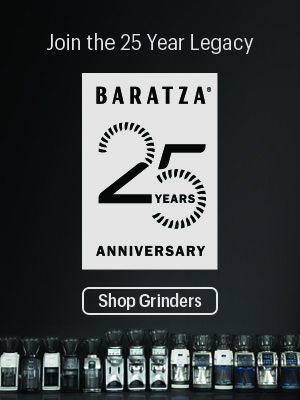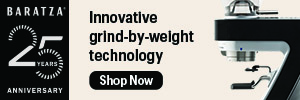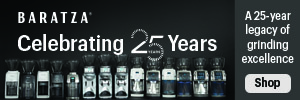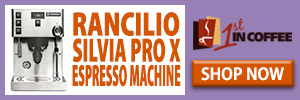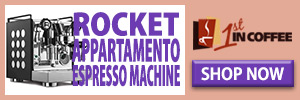Andrew Barnett of Ecco Caffè in Santa Rosa, California, tells the story of a Brazilian grower who once told him, in a voice redolent with horror and indignation, that another roaster had bought some of his best beans and had them decaffeinated. Until a fateful visit to my doctor last year, I probably would have nodded my head in agreement with the grower’s sentiment. But everything changed during that check-up, when, in response to a question about the arrhythmia that had left me unable to sleep without popping pills to control my fluttering heart, my doctor announced, “You are headed for an event that will change your life in an instant in ways you cannot even conceive of.”
This phrase was calculated to get my attention, and it did. As much as I love my espresso, I grudgingly conceded that continuing to walk upright and chew my own food was perhaps more important than the regular experience of thick, chocolaty, crema-laden ristrettos that used to coat my tongue with luscious coffee and caramel flavors that lingered on the palate for an hour or more. So I did it. I quit the real stuff cold turkey and reluctantly initiated a caffeine-free existence. About ten days later, the arrhythmia pretty much stopped.
My doctor also opined that even decaf was suspect, and for the first month or so, I didn’t even drink decaf. But once things seemed under control, I began to explore decaf espresso and entered a whole new world of coffee. Today, I begin my mornings by firing up the Giotto, reading the paper while she warms up, then making a real latte for my wife and a decaf latte for myself. (Felt-tip pen markings on my Mini Mazzer help orient me to the proper grinds for the various coffees I use, but a lot of shots go down the sink in the process.)
Ultimate Coffee Lovers Get Little Respect
It’s been suggested that decaf drinkers are the ultimate coffee lovers. According to Timothy J. Castle, coauthor with Joan Reis Nielsen of “The Great Coffee Book,” if you’re a decaf drinker, “You’re drinking coffee because you love the flavor of it. You’re not addicted to it any more, and I think we as an industry should cherish these coffee drinkers.” The industry, he adds, pays a lot more attention to organic and fair-trade coffee than it does to decaf, despite the fact that decaf drinkers make up 18 percent of the market.
In Italy, reports Caffé D’arte owner Mauro Cipolla, the decaf drinker is treated with even less respect. “I have maybe encountered five decaf bean grinders in all my travels in Italy thus far,” he reports. According to Cipolla, most Italian bars use pre-ground or instant decaf espresso, while others are introducing a machine that prepares Orzo, a barley-based drink, as a substitute for decaf espresso.
Counter Culture Coffee’s Peter Giuliano points out that many American cafés also use pre-ground decaf to save the expense of a second grinder, or they simply don’t take the care required to prepare decaf well. “If you treat decaf like a stepchild, it’s going to taste like a stepchild,” he observes. “If people use the same sort of energy and care with creating decaf beverages, from roasting to the barista-ing, I think you can get phenomenal results.”
In researching this article, I talked to a range of coffee people, from decaffeinators to roasters to green bean buyers, and I sampled a lot of decaf espressos (as you’ll see in my list of decaf espressos). The good news is that in recent years, a few roasters and decaffeinators have broken away from the line of thinking that sees decaffeination as a waste of a good bean, and they have started to put top-quality beans though the process, providing decaf drinkers with better-quality coffee than they could dream about only a few years ago. The bad news is that the industry has only begun to explore the possibilities. As Ken Davids, editor of Coffee Review, puts it, “I have lots of questions and not many answers.
Three Methods for Decaffeination
Commercial decaffeination was born in Germany in 1905, when Ludwig Roselius and Karl Wimmer developed a method that used benzene to remove the caffeine from green beans. In this approach, now known as the direct method, green beans are first hydrated to open the pores, then soaked or rinsed with a solvent that extracts the caffeine, steamed to remove solvent residues and then dried. Benzene, an extremely toxic chemical, was subsequently replaced by methylene chloride. More recently, ethyl acetate has been added to the direct decaffeinator’s arsenal.
Methylene chloride is a very efficient decaffeinator, and its low boiling point (104 degrees Fahrenheit) means that the residues can be steamed off at a very low temperature. But health concerns have led some roasters to shy away from it. (Proponents argue that the residue left in the beans is well below the amount allowed by the FDA and virtually disappears during the roasting process.) Ethyl acetate, which is derived from fruit, is considered more “natural,” but it has a much higher boiling point (174 degrees Fahrenheit), meaning the beans are subject to much more heat in the steaming process.
In the initial stage of the water-decaffeination process, green beans are soaked in water to create an extract that includes both the coffee compounds and the caffeine. The extract is then filtered through carbon to remove the caffeine so that it can be used to extract caffeine from subsequent batches of beans while leaving most of the other flavor compounds intact. The extract is then used repeatedly to decaffeinate new batches of coffee, and it is filtered through carbon as necessary to remove the caffeine.
In the early days of this process, the beans to be decaffeinated experienced longer contact time with the heated green coffee extract, practically soaking in it. But today, in the Swiss Water process at least, the beans are placed in vertical cylinders, and the extract, which is heated to around 175 degrees Fahrenheit, is trickled down through a tower of beans to minimize bean-to-liquid contact time while still efficiently extracting caffeine.
Finally, we have the super-critical gas method, in which the beans to be decaffeinated are hydrated and then immersed in heated CO2 at intense pressure (220 to 300 bars). At these temperatures, the gaseous CO2 is compressed to a liquid, causing caffeine to diffuse out of the bean and dissolve into the liquid CO2.
Little Consensus on the Best Method
There is considerable debate over which decaffeination method yields the best results, and no two experts seem to agree. George Howell of the George Howell Coffee Company uses methylene chloride and is impressed by CO2, but dislikes coffees decaffeinated with ethyl acetate. When initially contacted for this article, he also had a negative opinion of the water method, but in a recent tasting of some Swiss Water Costa Ricans, he found them “dazzling” and completely changed his opinion. Davids says, “I’ve had good coffees decaffeinated by all the methods and I’ve had lousy coffees, but personally, I like ethyl acetate because it tends to have kind of a sweet, round profile.” Caffé D’arte’s Cipolla says methylene chloride “gives us the best flavor characteristics and best body.” At Counter Culture, Giuliano uses the CO2 method most of the time, but also likes Swiss Water. Intelligentsia’s Geoff Watts says he’s had good results with both the direct and water methods.
A frustration expressed by several roasters is the difficulty, if not impossibility, of arranging a head-to-head comparison. The problem, says Watts, is that “most decaffeination companies I’ve talked with are unable, or unwilling, to decaffeinate very small batch sizes so that we could send a bit of the same coffee to each of them and then conduct some taste and longevity evaluations to get an idea of how the coffee quality is affected.” Indeed, most decaffeinators seem to have a minimum in the neighborhood of 50 bags, which would make a head-to-head test an extremely expensive proposition.
Asked about their 55-bag minimum, Swiss Water’s Diana Chan says they don’t have a table-top decaffeinator that can duplicate the process, and introducing a “tea bag” of beans into one of their bean columns could compromise normal operations and “would also not be truly representative of how the coffee would turn out.” But she adds that they are happy to provide interested customers with pre- and post-samples of the same lots. Carmen de Aldecoa-Baizan of Eximius in Houston, which uses methelyne chloride, says her company will decaffeinate as few as 20 bags. But when asked about the possibility of decaffeinating a sample, she says the process is too complex and lengthy for that to be practical.
One thing everyone seems to agree on is that decaffeinated green has a significantly shorter shelf life than regular green. That, in combination with the large minimums, leaves a small roaster who has an interest in developing an exemplary decaf program with only one choice: buying beans that have already been decaffeinated by dealers.
Good News for Decaf Drinkers
Fortunately, small roasters have a much better selection to choose from than they did 10 years ago. One dealer cited by several people interviewed for this article was Royal Coffee in Emeryville, California, which has been a pioneer in decaffeinating top-quality beans. Royal co-owner Helen Nicholas says that in the past, most of the decaf green available on the market was “low-grade, baggy coffee.”
In their own work, Nicholas says, Royal has had excellent results doing Ogsadey’s Ethiopians in Bremen using the methylene-chloride process, Colombians in Colombia using ethyl acetate and various organics with Swiss Water. Three years ago, Royal launched its “Royal Select” line, using the Mountain Water process in Mexico to decaffeinate Sulawesi, Tanzanian, Kenya, Harrar and Yemen, among others. In the end, says Nicholas, “What we’ve found is that if you use good coffee to begin with, you get good coffee back. Big surprise, right?”
Larger roasters like Counter Culture and Intelligentsia source their own beans, ship them directly to a decaffeinator, and then ship them to their roasting plants, a process known as tolling. Watts says that as the company’s Black Cat Espresso gained in popularity, it became clear that they needed a decaf version. Working with Swiss Water, Intelligentsia developed a decaf Black Cat using the same beans, but they made small adjustments to try to account for the impact of the decaffeination. Watts says the coffee has been a big success, and they also sell a lot of it as a traditional drip coffee.
Do certain types of beans lend themselves to decaffeination better than others? Swiss Water’s Chan says that Central and South American coffees respond well to the process, but with a coffee like Kenyan, the “delicate bouquet” can be reduced. She adds that “origins such as Indonesians and Ethiopians maintain their aroma and body, and blends of origins produce an excellent, balanced cup.”
Watts, on the other hand, cites Kenyan as a good choice, observing that “acidity seems to be particularly affected, and most decafs will be tamer or quieter tasting than the regulars. So it is perhaps true that the coffees most suitable for decaffing are either those with massive acidity that can retain some punch even after processing (think Kenya or Huehue Tenango) or those whose real appeal lies in other areas, like sweetness and body (think Brazil or perhaps Java or Jamaica).” Giuliano agrees that decaffeination tends to reduce acidity; he says the best candidates are “bright, hard coffees … the type of coffees that are at the top of the heap anyway.”
Watts suggests that the steaming involved in decaffeination helps clean the beans, and that the process can actually “improve the taste of a bad coffee.” On a similar note, Davids notes that it’s easy to find good decaf Sumatras, a fact he associates with the removal during the steaming process of the waxy layer on the outside of the bean, which he believes to be the source of a musty off-taste he sometimes finds in regular Sumatras.
When it comes to roasting profiles, Chan observes that decaf beans tend to be dryer than regular, and therefore don’t conduct heat as well – a factor that can lead to over-roasting the outside of the bean without adequately roasting the inside. Everyone interviewed for this article agreed that decaf must be roasted more gently than regular coffee. It’s also recommended that it can be dangerous to depend on visual clues because the beans are darker to begin with – especially those processed with water.
If everyone agrees that decaffeinated green goes stale more quickly than regular green, less thought appears to have been given to the shelf life of roasted decaf. Asked about decaf’s tendency to go stale more quickly than regular coffee, several experts suggested that this is an area that needs more study.
For Davids, yet another mystery is how decaf behaves in the grinder and why frequent grinder adjustments seem necessary in preparing decaf espresso. While many regular espresso blends are very forgiving and produce relatively consistent shots, decafs tend to be quirky and are more susceptible to channeling than regular. Davids’ best guess is that unstable moisture content is the culprit.
Bringing things back to retail, Giuliano adds an interesting observation. He says that while decaf costs the café owner more and requires more attention, the customer is not asked to pay a premium. The roaster’s margin is smaller, he observes, and the coffeehouse’s margin definitely is as well. “This,” he argues, “is the main reason people make compromises. And so far nobody I know of has broken that precedent.”
The Territory Ahead
Looking to the future, there are at least two possibilities that could transform the world of decaf drinkers. One intriguing option is the development of a genetically modified coffee tree. John Stiles, chief scientific officer of Integrated Coffee Technologies in Hawaii, says he’s confident he has solved the technical challenges and hopes to begin field tests next year. “It’s going to be regular coffee without going through a chemical extraction,” says Stiles, “so we would anticipate it’s going to be the best caffeine-free coffee you could get.”
Stiles, of course, must deal with the segment of the population that views genetically modified foods with strong suspicion, but he contends he can overcome that problem, saying, “We’ve had commercially produced genetically modified crops in the U.S. since 1984, and the predictions have not borne out.”
Another possibility is the fabled naturally decaffeinated tree. In 2004, a Brazilian scientist named Paulo Mazzafera announced that scientists from the Universidade Estadual de Campinas had identified a naturally decaffeinated Ethiopian coffee tree. But Mazzafera doesn’t seem to have been heard from since, and it has been suggested that Ethiopia may have raised issues over the ownership of the tree. Beyond that, the quality of the beans from this tree remains a large unknown.
Still, George Howell observes, “If a naturally modified decaf Arabica plant arrived on the scene, it would transform the industry. I would not want to own any decaffeination stock.”
Decaf Espresso, a Very Subjective List
This list of decaf espressos is offered with (at least) two qualifications. First, my formative experience of espresso was in Naples, and the Neapolitan ristretto has remained my standard for espresso, despite the clear preference for lighter roasts among the vast majority of serious American roasters. Secondly, I should stipulate that I did not test the coffees at various temperature settings to find the sweet spot of each blend. Hence, this should be seen as nothing more than one espresso lover’s assessment. All coffees were sampled within a week of the roast date.
Caffé D’arte Decaf Espresso (methylene chloride)
Before I had to give up the real stuff, Caffé D’arte’s Parioli blend was the blend I kept coming back to. This is the darkest decaf roast I tried, and it’s a very assertive coffee. The flavors are definitely toward the clove / tobacco end of the flavor chart; no citrus and spicy notes here, but lots of chocolate. Excellent body / persistent crema. In a milk-based drink, I can almost convince myself that I’m drinking the real thing.
Intelligentsia’s Black Cat Espresso (Swiss Water process)
A lot of chocolate, mild acidity and good body. I’m not sure how to describe this, but this coffee just sings of freshness, and it seems to have a longer shelf life than others I tried. The quality of the beans is obvious. It shows equally well as a straight shot and in a milk-based drink.
Terroir La Lapa Northern Italian Style Decaf Espresso (methylene chloride)
Mild and spicy with a lot of orange notes, light body. The quality of the beans is right there on the palate, and I like it as a straight shot and in milk-based drinks.
Royal Coffee’s KOMODO blend, roasted by Ecco Caffè (Swiss Water process)
Mild with lots of citrus notes, light body, good crema. Comes through nicely in milk-based drinks.
Counter Culture Decaf Espresso (CO2)
A really surprising range of flavor notes, from the top to the bottom of the flavor chart – citrus to tobacco. Lots of crema, light body.
This article is reprinted from the July 2006 issue of Fresh Cup magazine, with their kind permission.











